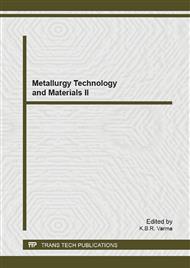p.427
p.431
p.435
p.443
p.447
p.452
p.456
p.460
p.465
Effects of H2 Flow Rate and H2 Plasma Treatment on the Properties of AZO Films
Abstract:
In this study, a 1350oC-sintered 98 mol% ZnO-1 mol% Al2O3 (AZO, Zn:Al= 98:2) ceramic was used as a target and deposited on glass using a r.f. magnetron sputtering system at a deposition temperature of 200°C. The effects of different H2 flow rates (H2/(H2+Ar)=0% ~ 9.09%, abbreviated as H2-deposited AZO films) added during the deposition process on the crystallization, resistivity, and optical transmission spectrum of AZO films were investigated. The Burstein-Moss shift effects were measured and used to prove that the defects of AZO films decreased with increasing H2 flow rate. For comparison, the 2% H2-deposited AZO films were also treated by the H2 plasma at room temperature for 60 min (plasma-treated AZO films). The effects of H2 plasma on the properties of the H2-deposited AZO films were also studied. The value variations in the optical band gap (Eg) of the H2-deposited and plasma-treated AZO films were evaluated from the plots of (αhv)2 = c (hν-Eg).
Info:
Periodical:
Pages:
447-451
Citation:
Online since:
September 2013
Authors:
Keywords:
Price:
Сopyright:
© 2013 Trans Tech Publications Ltd. All Rights Reserved
Share:
Citation:


